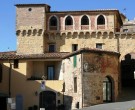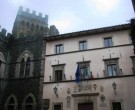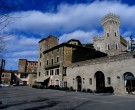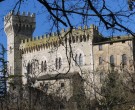> Home > What to visit > Old Town

San Casciano dei Bagni San Casciano dei Bagni
OLD TOWN
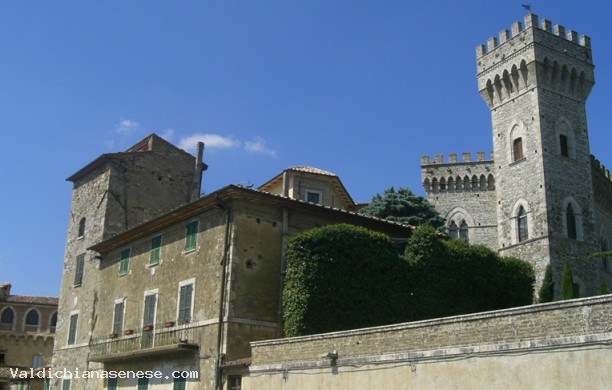
PHONE NUMBERS AND TIMES
San Casciano dei Bagni
Business card (vCard)
The birth and development of San Casciano dei Bagni is essentially linked to the presence of several hot water springs in its territory.
Tradition states that it was the Etruscan “Lucumone” (main leader, king) of Chiusi, Porsenna, that founded the “Chiusini Baths”, later appreciated and frequented also by Romans; be it for the effectiveness of the waters that for the nearness to Rome and to the Via Cassia. The Emperor Ottaviano Augusto and Triaria, Emperor Vitellio’s wife, were among the illustrious visitors during Roman times. The vitality of this center is also testified by the precocious penetration of Christendom. A parish called Saint Mary “ad Balnea”, already existed next to the hot springs, during the IVth and Vth century The end of the Roman Empire brought a quick deterioration of Italian hydrotherapy. The barbarian invasions, the struggles between Longobards and Byzantines, drastically contributed to the urban and demographic reorganization of San Casciano. The families of San Casciano were reduced by a fifth, the suburbium, the district mentioned in an ancient document discovered in the XVIth century, disappeared. Medieval times, saw San Casciano submitted to the feudal dominion of the Visconti of Campiglia, and to the rights exercised by the Abbey of San Salvatore and the ancient diocese of Chiusi. During this period the first written news appear : donation by the Marquis Ugo of Tuscany to the Abbey of San Salvatore , of the “Curtis de Bagno” (995), confirmed by the Emperors Otto III and Henry II; other news concerning the parish of Saint Mary, are dated 1014, 1020, 1067 and 1075. In 1191, the parish is mentioned in a Papal Edict by Celestine III, in 1226 Fredrick II confirms the ownership of the castles of San Casciano and Figline to the Visconti of Campiglia. During the XIIIth century hydrotherapy undergoes a revival, and thanks to this, San Casciano regains vitality , thanks also to the vicinity of the Via Francigena .It’s interesting to recollect the misfortune, in this period of the Abbot of Cluny, kidnapped by Ghino di Tacco, while going to San Casciano to cure his stomach and liver, as Boccaccio in the Decameron brings to memory. The Visconti of Campiglia, also Lords of San Casciano, soon found themselves pressed by the ambitions of expansion of Siena and of Orvieto and not being able to oppose the military and political supremacy of the two Townships, were forced to side alternately with one or the other, according to the periods and the necessities. At first, they sided with the Sienese, becoming extreme supporters of the Ghibellines and obtaining in this way the privilege of imperial protection by Frederick, the Red bearded . From 1215, they sided with the Guelphs, that is Orvieto’s side, establishing important contacts with Florence. The new alliance involved the people of San Casciano in the bloody defeat of Montaperti ( September 4th 1260). The weakening of the feudal Visconti family brought ,around the first half of the XIVth century , the division of the family in two branches: one “Sienese” resident in Campiglia d’Orcia and one “Orvietan” in San Casciano, linked to the Cervara branch of the Monaldeschi family of Orvieto, with whom the Visconti family shared the results of the long Orvietan civil war fought against the Monadelschi della Vipera. Monaldo Visconti, the last Lord of San Casciano, obtained important military successes with the troops of San Casciano against the partisans of the Monaldeschi della Vipera family, in the northern territories of the state of Orvieto, so much so to be elected Bailiff of Florence in 1389. In spite of the vicinity of Orvieto and Florence, it was Monaldo, himself, who decreed the reconciliation with Siena, first with the agreements of 1383 and 1386 and then with the definite submission on June 15th, 1412. When his son, John, renounced to all the rights that his family had on San Casciano and Figline, the Visconti family left forever the history of San Casciano. Important privileges were granted to San Casciano by the Sienese authorities. After the plundering in 1495 by the troops of VItellozzo Vitelli, San Casciano found itself involved in the continuous wars, that devastated particularly all the southern boundary of the Sienese State. At the apex of the numerous wars, Cosimo de’ Medici, Duke of Florence conquered Siena (1555). With the Peace treaty of Cateau-Cambrésis Siena lost its independence, thus Cosimo de’ Medici was able to create the Grand Duchy of Tuscany . With the new state organization San Casciano could count on the support and protection of Aurelio Manni, one of the most trusted assistants of the Grand Duke. As the war turbulence of the first half of the XVIth century ended, the hot springs rapidly recovered and until the entire XVIIth century were frequented by noblemen and prelates from Italy and Europe. To underline the importance of the hot springs, the Gran Duke Ferdinand I de’ Medici , in 1607, commissioned the realization of arcades on the spot, where the springs of the Ficoncella appear on the surface. The Grand Duke Peter Leopold I of the house of Habsburg Lorena visited San Casciano on October 24th, 1769,and he was struck by the quantity and by the temperature of the hot springs. In 1777, the communities of Celle sul Rigo, Figline, Camposervoli and Le Piazze ( the last two will be then transferred to the township of Cetona ) were embodied in the township of San Casciano.
STAY NEARBY
PODERNOVO
SAN CASCIANO DEI BAGNI
Podernovo is an old farmhouse, of the 19th century, made of stone, only 2 km. far from the...SETTE QUERCE
SAN CASCIANO DEI BAGNI
The Albergo Sette Querce is situated only a few meters from the historic center of San Cas...LA FONTANELLA
SAN CASCIANO DEI BAGNI
In a splendid natural setting, only 200 meters from the Terme and from the historical cent...DINING & ENTERTAINMENT NEARBY
Teatro Comunale ex Accademia dei Georgofili Accalorati
SAN CASCIANO DEI BAGNI
In this important and active center of the Valdichiana 700 was already at the end of the a...Acque Fonteverde, Parco Termale e Hotel
SAN CASCIANO DEI BAGNI
Situate ad un chilometro circa a sud del Centro Storico di San Casciano, nel raggio di ci...Parco delle Piscine
SARTEANO
Situatoa 573 metri di altitudine, in prossimità del centro storico di Sarteano,&nbs...



